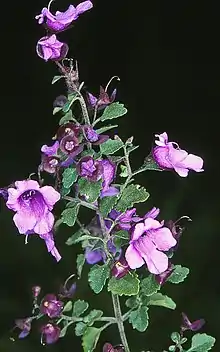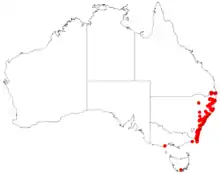| Cut-leaved mint-bush | |
|---|---|
 | |
| Near Bega | |
| Scientific classification | |
| Kingdom: | Plantae |
| Clade: | Tracheophytes |
| Clade: | Angiosperms |
| Clade: | Eudicots |
| Clade: | Asterids |
| Order: | Lamiales |
| Family: | Lamiaceae |
| Genus: | Prostanthera |
| Species: | P. incisa |
| Binomial name | |
| Prostanthera incisa | |
 | |
| Occurrence data from AVH | |
| Synonyms[1] | |
|
List
| |
Prostanthera incisa, commonly known as cut-leaf mint-bush[2] or native thyme, is a species of flowering plant in the family Lamiaceae and is endemic to south-eastern continental Australia. It is an erect, strongly aromatic, openly branched shrub with hairy, densely glandular branches, egg-shaped to oblong leaves, and pale mauve to mauve flowers.
Description
Prostanthera incisa is an erect, openly-branched, "strongly and rather unpleasantly"[3] aromatic shrub or has a "pleasing aroma emanating from the sensitive leaf glands" according to George Althofer.[4] The shrub has ridged, hairy, densely glandular branches. The leaves are hairy, densely glandular, egg-shaped to oblong, paler on the lower surface, 8–30 mm (0.31–1.18 in) long and 4–12 mm (0.16–0.47 in) wide on a petiole 1–10 mm (0.039–0.394 in) long. The edges of the leaves are coarsely toothed and the tip is rounded. The flowers are arranged in bunches near the end of the branches with bracteoles about 1 mm (0.039 in) long but that fall off as the flower develops. The sepals are 3–4.5 mm (0.12–0.18 in) long, forming a tube about 2 mm (0.079 in) long with two lobes, the upper lobe about 2 mm (0.079 in) long. The petals are pale mauve to mauve and 7–10 mm (0.28–0.39 in) long.[2][3]
Taxonomy
Prostanthera incisa was first formally described in 1810 by Robert Brown in his book Prodromus Florae Novae Hollandiae et Insulae Van Diemen, and it still bears its original name.[5][6]
Distribution and habitat
Cut-leaved mint-bush is found along the New South Wales coastline from Mount Warning near the Queensland border all the way to Victoria, as well as on the Central Tablelands of New South Wales.[2] It is found in sheltered sites in rainforest margins or sclerophyll forest under such trees as Sydney blue gum (Eucalyptus saligna), cabbage gum (E. amplifolia), Sydney peppermint (E. piperita), red bloodwood (Corymbia gummifera) or turpentine (Syncarpia glomulifera). It can also occur in scrub along watercourses in association with river she-oak (Casuarina cunninghamiana).[7]
Use in horticulture
First grown in England in 1824,[8] P. incisa var. incisa is cultivated on a small-scale commercial basis for essential oil production and for bushfood spice. P. incisa prefers sheltered sites in well-drained acidic soils,[8] and in poorly drained soils it can be susceptible to root-rot. It has reasonable frost tolerance down to −5 °. It is a fast-growing shrub, and consequently can be harvested within the first year. When pruned back to a height of 50 cm it reshoots readily.
Propagation is by seed or cutting material of firm young growth.[8]
References
- 1 2 "Prostanthera incisa". Australian Plant Census. Retrieved 3 September 2020.
- 1 2 3 Conn, Barry J. "Prostanthera incisa". Royal Botanic Garden Sydney.
- 1 2 Conn, Barry J. "Prostanthera incisa". Royal Botanic Gardens Victoria. Retrieved 3 September 2020.
- ↑ Althofer, George (1978). Cradle of Incense. The Society for Growing Australian Plants. p. 71. ISBN 0909830134.
- ↑ "Prostanthera incisa". Australian Plant Name Index. Retrieved 3 September 2020.
- ↑ Brown, Robert (1810). Prodromus Florae Novae Hollandiae et Insulae Van Dieman. London: typis R. Taylor et socii,1810. p. 509. Retrieved 3 September 2020.
- ↑ Benson, Doug; McDougall, Lyn (1997). "Ecology of Sydney Plant Species, Part 5 - Dicotyledon families Flacourtiaceae to Myrsinaceae". Cunninghamia. 5 (2): 426. Retrieved 3 September 2020.
- 1 2 3 Elliot, Rodger W.; Jones, David L.; Blake, Trevor (1997). Encyclopaedia of Australian Plants Suitable for Cultivation: Volume 7 – N-Po. Port Melbourne: Lothian Press. p. 26; 221. ISBN 0-85091-634-8.